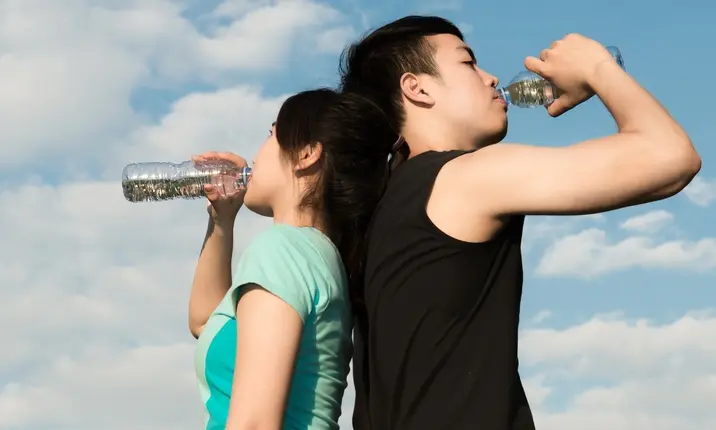

Source: Shutterstock
The Science Behind Why We Fall in Love
Last updated: Thursday, September 3, 2020 | 4 min reading time
Do you believe in love at first sight? How about love at first smell? Read on to discover the science behind falling in love this Valentine’s Day.
We talk about the moment of falling in love as if we have been hit by Cupid's arrow – it is intense, overwhelming, sometimes fast and can feel like fate. As time passes, this initial bust of feeling often fades into a comfortable closeness.
The initial happy feelings of being in love is stimulated by 3 chemicals in the brain: noradrenaline that stimulates adrenaline production causing that racing heart and sweaty palms; dopamine, the feel-good chemical; and phenylethylamine that is released when we're near our crush, giving us butterflies in our tummies.
But is there a biological reason behind these feelings? And why do you fall in love with that one person you do?
There are 3 distinct phases of falling in love. The first, lust, is driven by the levels of testosterone (men) and oestrogen (women) in our bodies. The second, attraction, is similar in feeling to the addictive rush from certain drugs or alcohol. The final phase is attachment, which is when you may begin to feel closely bonded and start making long-term plans together.
The 3 stages of love
According to Dr Helen Fisher, a renowned anthropologist, there are 3 distinct phases of falling in love.
Stage 1: Lust is driven by the levels of testosterone (men) and oestrogen (women) in our bodies. This isn't so different from other mammals on the planet.
Stage 2: Attraction is similar in feeling to the effect of certain drugs or alcohol. The emotion of euphoria, and the release of a jumble of chemicals in the brain, including dopamine (pleasure), adrenaline (fight or flight) and norepinephrine (alertness), can make falling in love feel like an addictive rush. Adrenaline, in particular, is the reason your cheeks feel flushed, your palms feel sweaty and your heart races when you meet someone you like for the first time.
Stage 3: Attachment sees the release of dopamine and norepinephrine replaced with oxytocin (the 'cuddle' hormone), which is when you may begin to feel closely bonded and start making long-term plans together.
While the 3 phases of love might seem straightforward, there are several other factors that affect who you end up falling in love with. Many of us say we have a 'type', but is that true? Here are 4 scientific reasons why you might fall in love with someone!
Their smell
Did you know that we all secrete our own special 'smell'? Like hormones, pheromones are chemicals, but the difference is they are outside the body, lingering in our sweat and other bodily fluids – and the science suggests this is a subconscious factor in your initial attraction to someone.
If you're female, this can be closely linked to the health of your potential children. In one study, female participants were asked to rate the smell of several T-shirts, slept in by various men. Overall, the women preferred the scents of men who had disease-resistance genes profiles that would complement their own. This suggests we subconsciously look for a partner that will help us to produce strong, healthy babies, resistant to as many diseases as possible. Who knew?
How similar they are to you
Your nose may be sniffing for a different gene profile, but that doesn't stop us being attracted to like-minded people. One study of 1,523 couples, which analysed the similarity of individual personality traits, found that happy couples' personalities synced up 86% of the time.
And it's not just personality traits – you're also likely to be attracted to someone who has similar values and beliefs to you. In another study of 1,500 pairs, every single couple held similar life views, including the ones who had only just met.
Their appearance
Beauty is in the eye of the beholder – but there are still several ways in which appearance has a subconscious impact on whom you are attracted to.
For example, having a symmetrical face is generally considered a hallmark of conventional attractiveness. Studies have found that having a symmetrical face implies the presence of 'good' genes, while an overly lopsided face may imply poor health, alcohol abuse or smoking.
Meanwhile, in men, having a longer ring finger in comparison to the index finger is an indicator of more testosterone, and therefore a higher sperm count, increased fertility, a healthier heart and better genes.
However, overcoming all of that is your own life experiences, which is why your preference and taste in appearance is very much unique to you!
A study has found that who we find attractive is most strongly influenced by our life experiences, such as the kind of faces you are exposed to and the relationships you form. For example, having a positive relationship with someone may have you subconsciously pairing their facial characteristics with positive information. Subsequently, people who look similar to them become more attractive to you as well.
Research also suggests that familiarity and exposure to certain faces increases their attractiveness. That means you may prefer faces that are similar to those you're more familiar with, and tend to judge a face that is very different from faces you've previously seen as less attractive.
Their BMI (body mass index)
Traditionally, a waist-hip ratio of 7:10 has been held up as the ideal for feminine attractiveness, while women look for a man with a waist-to-hip ratio of 9:10.
But according to one study, it's more important to have a healthy BMI. Apparently, men find women with a BMI of 18 – 20 most attractive, as it indicates both good health and fertility.
Meanwhile, women are subconsciously looking for a man with body fat of around 12% – probably because too high body fat is associated with a range of negative health implications, including heart disease, diabetes and reduced fertility.
Chatel, A. (2016, April 13). Why We’re Attracted to People Just Like Us, According to Science. Retrieved January 9, 2017, from https://www.bustle.com/articles/153908-why-were-attracted-to-people-who-are-just-like-us-according-to-science
Chemistry of Love. (n.d.) Retrieved September 3, 2020, from https://asdn.net/asdn/chemistry/chemistry_of_love.php
Furlow, F. B. (2016, June 9). The Smell of Love. Retrieved January 9, 2017, from https://www.psychologytoday.com/sg/articles/199603/the-smell-love
Gregoire, C. (2015, February 14). The Strange Science of Sexual Attraction. Retrieved January 9, 2017, from https://www.huffingtonpost.com/2015/02/14/science-of-attraction-_n_6661522.html
Knapton, S. (2016, February 23). Relationships: Opposites Do Not Attract, Scientists Prove. Retrieved January 9, 2017, from http://www.telegraph.co.uk/news/science/science-news/12170295/Relationships-opposites-do-not-attract-scientists-prove.html
Knapton, S. (2015, April 8). The Science of Sexiness: Why Some People Are Just More Attractive. Retrieved January 9, 2017, from http://www.telegraph.co.uk/science/2016/03/12/the-science-of-sexiness-why-some-people-are-just-more-attractive/
Laurance, J. (1998, August 13). Scientists Unlock the Secrets of Women’s Sexual Attractiveness. Retrieved January 9, 2017, from http://www.independent.co.uk/news/scientists-unlock-the-secrets-of-womens-sexual-attractiveness-1171463.html
Laws of Attraction: How Do We Select a Life Partner? (2014, December 2). Retrieved from https://www.psychologytoday.com/blog/insight-therapy/201412/laws-attraction-how-do-we-select-life-partner
Love, Actually: The science behind lust, attraction, and companionship - Science in the News. (2017, February 14). Retrieved from http://sitn.hms.harvard.edu/flash/2017/love-actually-science-behind-lust-attraction-companionship/
Sifferlin, A. (2015, October 1). Yes, You Really Do Have A ‘Type’, Science Says. Retrieved January 9, 2017, from http://time.com/4057616/yes-you-really-do-have-a-type-science-says/
The 3 Stages of Love and Hormones -. (2015, February 27). Retrieved from http://www.myvitawellness.com/3-stages-love-hormones/
The Chemistry of Love. (2018, February 14) Retrieved September 2, 2020, from https://www.reagent.co.uk/the-chemistry-of-love/#:~:text=The%20initial%20spark%20of%20falling,pleasure%2C%20energy%20and%20focussed%20attention.
Tigar, L. (2016, February 12). How Your Body Reacts When You Fall In Love. Retrieved January 9, 2017, from http://edition.cnn.com/2016/02/12/health/your-body-on-love/index.html
Chemistry of Love. (n.d.) Retrieved September 3, 2020, from https://asdn.net/asdn/chemistry/chemistry_of_love.php
Furlow, F. B. (2016, June 9). The Smell of Love. Retrieved January 9, 2017, from https://www.psychologytoday.com/sg/articles/199603/the-smell-love
Gregoire, C. (2015, February 14). The Strange Science of Sexual Attraction. Retrieved January 9, 2017, from https://www.huffingtonpost.com/2015/02/14/science-of-attraction-_n_6661522.html
Knapton, S. (2016, February 23). Relationships: Opposites Do Not Attract, Scientists Prove. Retrieved January 9, 2017, from http://www.telegraph.co.uk/news/science/science-news/12170295/Relationships-opposites-do-not-attract-scientists-prove.html
Knapton, S. (2015, April 8). The Science of Sexiness: Why Some People Are Just More Attractive. Retrieved January 9, 2017, from http://www.telegraph.co.uk/science/2016/03/12/the-science-of-sexiness-why-some-people-are-just-more-attractive/
Laurance, J. (1998, August 13). Scientists Unlock the Secrets of Women’s Sexual Attractiveness. Retrieved January 9, 2017, from http://www.independent.co.uk/news/scientists-unlock-the-secrets-of-womens-sexual-attractiveness-1171463.html
Laws of Attraction: How Do We Select a Life Partner? (2014, December 2). Retrieved from https://www.psychologytoday.com/blog/insight-therapy/201412/laws-attraction-how-do-we-select-life-partner
Love, Actually: The science behind lust, attraction, and companionship - Science in the News. (2017, February 14). Retrieved from http://sitn.hms.harvard.edu/flash/2017/love-actually-science-behind-lust-attraction-companionship/
Sifferlin, A. (2015, October 1). Yes, You Really Do Have A ‘Type’, Science Says. Retrieved January 9, 2017, from http://time.com/4057616/yes-you-really-do-have-a-type-science-says/
The 3 Stages of Love and Hormones -. (2015, February 27). Retrieved from http://www.myvitawellness.com/3-stages-love-hormones/
The Chemistry of Love. (2018, February 14) Retrieved September 2, 2020, from https://www.reagent.co.uk/the-chemistry-of-love/#:~:text=The%20initial%20spark%20of%20falling,pleasure%2C%20energy%20and%20focussed%20attention.
Tigar, L. (2016, February 12). How Your Body Reacts When You Fall In Love. Retrieved January 9, 2017, from http://edition.cnn.com/2016/02/12/health/your-body-on-love/index.html
 Brain & Spine Care
Brain & Spine Care







